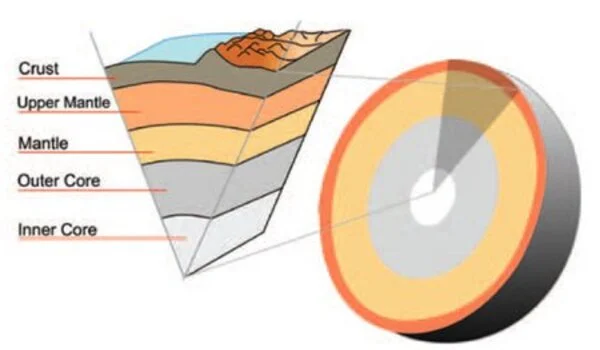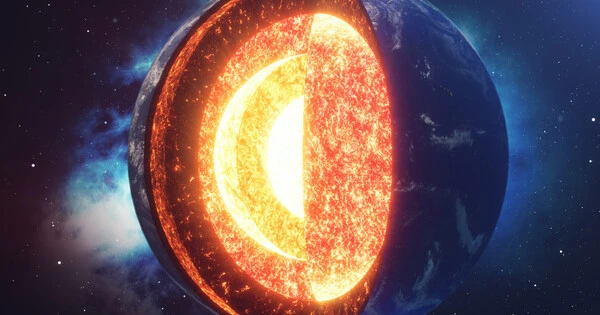Diamond is a metasomatic mineral that forms during the migration of carbon-bearing fluids, which means it forms from fluids and melts that move through the mantle. Diamonds can form in both peridotite and eclogite in the cratonic lithospheric mantle, as well as their higher-pressure equivalents in the much deeper transition zone and lower mantle.
Scientists discover that a potential “diamond factory” may have existed for billions of years at Earth’s core-mantle boundary. Steel rusts on the Earth’s surface due to water and air. But what about deep within the Earth’s core?
The Earth’s core is the largest carbon storage facility on the planet, with approximately 90% buried there. Scientists have discovered that the oceanic crust that sits on top of tectonic plates and subducts into the interior contains hydrous minerals and can sometimes descend all the way to the core-mantle boundary. The temperature at the core-mantle boundary is at least twice that of lava, and it is high enough for water to be released from hydrous minerals. As a result, at the Earth’s core-mantle boundary, a chemical reaction similar to rusting steel could occur.
Byeongkwan Ko, a recent Arizona State University Ph.D. graduate, and his collaborators published their findings on the core-mantle boundary in Geophysical Research Letters. They conducted experiments at the Advanced Photon Source at Argonne National Laboratory, where they compressed iron-carbon alloy and water together to the pressure and temperature expected at the Earth’s core-mantle boundary, melting the iron-carbon alloy.
Carbon is an essential element for life and plays an important role in many geological processes. The new discovery of a carbon transfer mechanism from the core to the mantle will shed light on the understanding of the carbon cycle in the Earth’s deep interior.
Byeongkwan Ko
The researchers discovered that water and metal react to form iron oxides and iron hydroxides, just like rusting at the Earth’s surface. They discovered, however, that under the conditions of the core-mantle boundary, carbon emerges from the liquid iron-metal alloy and forms diamond.
“At 3,000 km depth, the temperature at the boundary between the silicate mantle and the metallic core reaches roughly 7,000 F, which is sufficiently high for most minerals to lose H2O captured in their atomic scale structures,” said Dan Shim, professor at ASU’s School of Earth and Space Exploration. “In fact, the temperature is high enough that some minerals should melt under these circumstances.”
Because carbon is an iron-loving element, significant carbon is expected to exist in the core, while the mantle is thought to have relatively low carbon. However, scientists have found that much more carbon exists in the mantle than expected.

Shim explained, “At the pressures expected for the Earth’s core-mantle boundary, hydrogen alloying with iron metal liquid appears to reduce the solubility of other light elements in the core.” “As a result, the solubility of carbon, which is most likely present in the Earth’s core, decreases locally where hydrogen enters the core from the mantle (through dehydration). Diamond is the most stable form of carbon at the pressure-temperature conditions of Earth’s core-mantle boundary. As a result, the carbon that escapes from the liquid outer core becomes diamond when it enters the mantle.”
“Carbon is an essential element for life and plays an important role in many geological processes,” said Ko. “The new discovery of a carbon transfer mechanism from the core to the mantle will shed light on the understanding of the carbon cycle in the Earth’s deep interior. This is even more exciting given that the diamond formation at the core-mantle boundary might have been going on for billions of years since the initiation of subduction on the planet.”
According to Ko’s new research, carbon leaking from the core into the mantle via this diamond formation process may provide enough carbon to explain the elevated carbon levels in the mantle. Ko and his colleagues also predicted that diamond-rich structures could exist at the core-mantle boundary and that seismic studies could detect them because seismic waves should travel at unusually fast speeds for the structures.
“Seismic waves should propagate exceptionally fast through diamond-rich structures at the core-mantle boundary because diamond is extremely incompressible and less dense than other materials at the core-mantle boundary,” Shim explained.
Ko and colleagues will continue to investigate how the reaction affects the concentration of other light elements in the core, such as silicon, sulfur, and oxygen, and how such changes affect the mineralogy of the deep mantle.
















